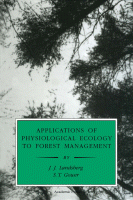Browse content
Table of contents
Actions for selected chapters
- Full text access
- Book chapterNo access
1 - Introduction: Forestry in the Modern World
Pages 1-17 - Book chapterNo access
2 - Forest Biomes of the World
Pages 19-51e - Book chapterNo access
3 - Canopy Architecture and Microclimate
Pages 51-88 - Book chapterNo access
4 - Forest Hydrology and Tree–Water Relations
Pages 89-124 - Book chapterNo access
5 - Carbon Balance of Forests
Pages 125-160 - Book chapterNo access
6 - Soil Organic Matter and Decomposition
Pages 161-184 - Book chapterNo access
7 - Nutrient Distribution and Cycling
Pages 185-228 - Book chapterNo access
8 - Changes in Ecosystem Structure and Function during Stand Development
Pages 229-246 - Book chapterNo access
9 - Ecosystem Process Models
Pages 247-276 - Book chapterNo access
10 - Applications of Modern Technology and Ecophysiology to Forest Management
Pages 277-300 - Book chapterNo access
Symbols and Definitions
Pages 301-303 - Book chapterNo access
References
Pages 304-349 - Book chapterNo access
Subject Index
Pages 351-354 - Book chapterNo access
Physiological Ecology
Pages 355-356
About the book
Description
Forest management is a complex process that now incorporates information obtained from many sources. It is increasingly obvious that the physiological status of the trees in a forest has a dramatic impact on the likely success of any particular management strategy. Indeed, models described in this book that deal with forest productivity and sustainability require physiological information. This information can only be obtained from an understanding of the basic biological mechanisms and processes that contribute to individual tree growth.
This valuable book illustrates that physiological ecology is a fundamental element of proficient forest management.
Forest management is a complex process that now incorporates information obtained from many sources. It is increasingly obvious that the physiological status of the trees in a forest has a dramatic impact on the likely success of any particular management strategy. Indeed, models described in this book that deal with forest productivity and sustainability require physiological information. This information can only be obtained from an understanding of the basic biological mechanisms and processes that contribute to individual tree growth.
This valuable book illustrates that physiological ecology is a fundamental element of proficient forest management.
Key Features
- Provides essential information relevant to the continuing debate over sustainable forest management
- Outlines how modern tools for physiological ecology can be used in planning and managing forest ecosystems
- Reviews the most commonly used forest models and assesses their value and future
- Provides essential information relevant to the continuing debate over sustainable forest management
- Outlines how modern tools for physiological ecology can be used in planning and managing forest ecosystems
- Reviews the most commonly used forest models and assesses their value and future
Details
ISBN
978-0-12-435955-0
Language
English
Published
1997
Copyright
Copyright © 1997 Elsevier Inc. All rights reserved
Imprint
Academic Press
